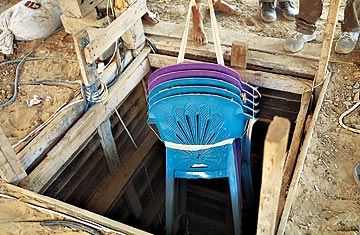
A pulley mechanism is used to raise goods out of a tunnel near Rafah. The plastic chairs were smuggled in from Egypt to refit a school destroyed by Israeli bombs, according to Palestinians.
There is no easy access to the Gaza Strip. When the Islamist organization Hamas took control of Gaza in 2007, Israel all but shut down the tiny coastal territory, imposing a suffocating blockade on Gaza's land and sea borders that keeps the people in and the goods out. That's when the roughly 1.5 million Palestinians living in Gaza turned to the tunnels. There are hundreds of underground passageways stretching from Gaza south into Egypt--some dug as deep as 100 ft.--used each day to transport commercial goods that range from food and baby formula to computers and even cars. They are Gaza's only lifelines to the outside world. "You have zero exports and zero commercial imports through the [Israeli-controlled] crossing points," says John Ging, head of the U.N. Relief and Works Agency in Gaza. "All that is allowed in is humanitarian aid and supplies ... In terms of economic activity, there is none other than the tunnel economy."
Tunnels differ from one another in size, shape and purpose and are built with varying degrees of sophistication. Some are shallow, fragile-looking dirt shafts with narrow openings; others have wide, wood-reinforced passageways. One tunnel, meant exclusively for livestock, descends gradually underground on both the Egyptian and Gazan sides. The workers say the inclines are easier on the cows and donkeys, which would otherwise have to be hauled out with a generator-powered pulley.
The nerve center of the tunnel economy is Rafah, a town of 150,000 just over the border from Egypt. The outskirts of the town are dotted with tents, tarps and bulldozers, marking the tunnel openings where goods are raised and lowered. In Najma Square, in the center of Rafah, the fruits of tunnel labor meet their first customers. Encircling the square are tables covered with TV sets, fans, blenders and generators, and stalls packed with refrigerators, washing machines and ovens--and this is just the electrical side of town. Moving west toward the border, you see more goods: boxes of cigarettes, giant bags of potato chips and sacks of cement. Then you pass the warehouses that sell the tools used to physically shape the tunnel industry: shovels, rope, pulleys and electrical cords, plus pickaxes, hammers, nuts, bolts and screws in all sizes. The industry of making the tunnels is a booming business on its own.
For Israel, the tunnels have always been a target. Before 2007, such tunnels were primarily for smuggling weapons used by Palestinian militants against Israeli civilians. Now Israel suspects that the Hamas government is profiting off the tunnel trade. Last winter Israeli forces destroyed most of the tunnel network, along with much of the Gaza Strip's infrastructure, during its three-week offensive, Operation Cast Lead. But the tunnel workers got right back underground. "We are just trying to earn a living here. We have no other choice," explains Abu Obeida, a potato-chip and clothing smuggler who has been working in tunnels for a year and a half. Says Khalid al-Hubi, a Rafah shopkeeper who deals mostly in smuggled generators: "Even if Israel destroys all of the tunnels entirely, I'm quite sure that the tunnels will only be dug again and again."
Gaza Underground
To see video from inside the smuggling tunnels of the Gaza Strip, go to time.com/tunnels
